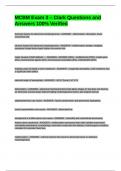Exam (elaborations)
MCBM Exam 3 – Clark Questions and Answers 100% Verified
- Module
- Institution
MCBM Exam 3 – Clark Questions and Answers 100% VerifiedMCBM Exam 3 – Clark Questions and Answers 100% VerifiedMCBM Exam 3 – Clark Questions and Answers 100% VerifiedMCBM Exam 3 – Clark Questions and Answers 100% VerifiedExtrinsic factors for abnormal morphogenesis - ANSWER - deformation, di...
[Show more]



